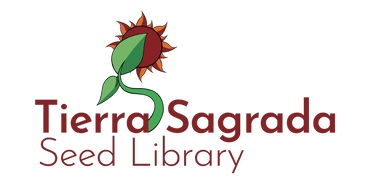Welcome to Tierra Sagrada, Las Cruces Public Libraires’ pop-up community seed sharing program. The Tierra Sagrada Seed Library was created to facilitate regionally-specific food and plant growing and to cultivate a community of seed savers.
Seeds will be available for most of the year, while supplies last. Library patrons can check out up to 10 packets of seeds, per season, on their library card.
Depending on the season and availability of certain stock we typically have the following species available for checkout at various times throughout the year:
- Arugula Basil Beans
- Borage Broccoli Carrots
- Catnip Chicory Chives
- Cilantro Corn Cucumber
- Eggplant Green Onion Kale
- Kohlrabi Lettuce Milkweed
- Okra Peas Pepper
- Radish Spinach Squash
- Sunflower Swiss Chard Tatsoi
- Tomato Watermelon Zucchini
- Wildflowers – Various
What is Seed Saving?
Seed saving is the process of growing and harvesting seeds in a way that ensures that seeds reliably match their parent plant(s) over multiple generations.
Why is seed saving important?
Seed saving allows for the reliable supply of genetically diverse crop varieties. The more varieties of crop we have the more likely it will be for crop varieties to exist which have beneficial characteristics such as pest resistance, drought tolerance or great taste. When plant varieties cross pollinate, we risk the possibility of losing certain beneficial characteristics. For this reason, it is important to keep a supply of seeds that reliably match their parent plant. So long as we have a reliable stock of seeds that we know the characteristics of we can experiment with cross pollinating different varieties to produce new plant varieties without the risk of losing beneficial characteristics.
Are cross-pollinated plants bad?
No, cross pollinated plant species are not inherently bad! Cross pollination is a completely natural process that ensures plant offspring variability. However, when plant varieties cross pollinate, sometimes certain beneficial characteristics are lost. Keeping a supply of saved seeds ensures that we always have access to those beneficial characteristics even if they have not been retained by a cross pollinated descendant population.
How to read my Seed Packet

Physical Address:
200 E Picacho Avenue
Las Cruces, NM 88001

The image above is an example of what is shown on a seed packet. Here is a step by step process of each line’s meaning and how to read your seed packet:
- The top line of text tells you what kind of plant your seeds will produce. Some examples include: flowers, beans, herbs, vegetables. In this example you can see the plant is “Vegetable – Leafy Green”.
- The next two lines of text provide you with the species common name and scientific name. In this example you can see that the common name is “Swiss Chard” and the scientific name is “Beta vulgaris”
- The third line describes the SS which stands for “seed source”. We get our seeds form a variety of natural growers as well as community donations. The Seed Source is followed by another set of initials which stand for the seed company. You can visit the seed company and find out more information about your varieties!
The seed companies are as follows:
NSS: Native Seed/SEARCH
SS: Siskiyou Seeds
SSE: Seed Savers Exchange
ST: Seeds Trust
BSPC: Burgess Seed and Plant Co.
TS: True Love Seeds
BCHS: Baker Creek Heirloom Seeds
FM: Ferry-Morse
Community: Community grown!
- The last line on the seed packet label provides the library phone number should you have any further questions about your seeds.
- The color-coded stars on your seed packets signify how easy or difficult it is to save seeds from that species of plant. A green star signifies that the species of plant has a very low rate of cross pollination, while red stars signify that species may cross pollinate very frequently. Yellow stars may indicate either that the species is prone to some cross pollination or that the species may be biennial and require care for two or more years rather than for a single season in order to produce seeds.
